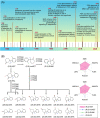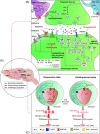The molecular pathophysiology of depression and the new therapeutics
- PMID: 35875370
- PMCID: PMC9301929
- DOI: 10.1002/mco2.156
The molecular pathophysiology of depression and the new therapeutics
Abstract
Major depressive disorder (MDD) is a highly prevalent and disabling disorder. Despite the many hypotheses proposed to understand the molecular pathophysiology of depression, it is still unclear. Current treatments for depression are inadequate for many individuals, because of limited effectiveness, delayed efficacy (usually two weeks), and side effects. Consequently, novel drugs with increased speed of action and effectiveness are required. Ketamine has shown to have rapid, reliable, and long-lasting antidepressant effects in treatment-resistant MDD patients and represent a breakthrough therapy for patients with MDD; however, concerns regarding its efficacy, potential misuse, and side effects remain. In this review, we aimed to summarize molecular mechanisms and pharmacological treatments for depression. We focused on the fast antidepressant treatment and clarified the safety, tolerability, and efficacy of ketamine and its metabolites for the MDD treatment, along with a review of the potential pharmacological mechanisms, research challenges, and future clinical prospects.
Keywords: (R)‐ketamine; (S)‐ketamine; ketamine; major depressive disorder (MDD).
© 2022 The Authors. MedComm published by Sichuan International Medical Exchange & Promotion Association (SCIMEA) and John Wiley & Sons Australia, Ltd.
Conflict of interest statement
The authors disclose no potential conflicts of interest.
Figures





Similar articles
-
Ketamine and its metabolites: Potential as novel treatments for depression.Neuropharmacology. 2023 Jan 1;222:109305. doi: 10.1016/j.neuropharm.2022.109305. Epub 2022 Oct 30. Neuropharmacology. 2023. PMID: 36354092 Review.
-
Exploring Esketamine's Therapeutic Outcomes as an FDA-Designated Breakthrough for Treatment-Resistant Depression and Major Depressive Disorder With Suicidal Intent: A Narrative Review.Cureus. 2024 Feb 10;16(2):e53987. doi: 10.7759/cureus.53987. eCollection 2024 Feb. Cureus. 2024. PMID: 38476783 Free PMC article. Review.
-
Rapid-acting antidepressant ketamine, its metabolites and other candidates: A historical overview and future perspective.Psychiatry Clin Neurosci. 2019 Oct;73(10):613-627. doi: 10.1111/pcn.12902. Epub 2019 Jul 11. Psychiatry Clin Neurosci. 2019. PMID: 31215725 Free PMC article. Review.
-
The promise of ketamine for treatment-resistant depression: current evidence and future directions.Ann N Y Acad Sci. 2015 May;1345(1):47-58. doi: 10.1111/nyas.12646. Epub 2015 Feb 3. Ann N Y Acad Sci. 2015. PMID: 25649308 Free PMC article. Review.
-
The Efficacy and Safety of Intranasal Formulations of Ketamine and Esketamine for the Treatment of Major Depressive Disorder: A Systematic Review.Pharmaceutics. 2023 Dec 13;15(12):2773. doi: 10.3390/pharmaceutics15122773. Pharmaceutics. 2023. PMID: 38140113 Free PMC article. Review.
Cited by
-
Gut Microbiota Alterations and Their Functional Differences in Depression According to Enterotypes in Asian Individuals.Int J Mol Sci. 2023 Aug 28;24(17):13329. doi: 10.3390/ijms241713329. Int J Mol Sci. 2023. PMID: 37686135 Free PMC article.
-
Effect of combination therapy of methylfolate with antidepressants in patients with depressive disorder.BMC Pharmacol Toxicol. 2025 Jan 22;26(1):14. doi: 10.1186/s40360-025-00846-x. BMC Pharmacol Toxicol. 2025. PMID: 39844190 Free PMC article. Clinical Trial.
-
Beyond NMDA Receptors: A Narrative Review of Ketamine's Rapid and Multifaceted Mechanisms in Depression Treatment.Int J Mol Sci. 2024 Dec 20;25(24):13658. doi: 10.3390/ijms252413658. Int J Mol Sci. 2024. PMID: 39769420 Free PMC article. Review.
-
Dietary acid load, depression, and anxiety: results of a population-based study.BMC Psychiatry. 2023 Sep 18;23(1):679. doi: 10.1186/s12888-023-05163-3. BMC Psychiatry. 2023. PMID: 37723484 Free PMC article.
-
The Melanocortin System: A Promising Target for the Development of New Antidepressant Drugs.Int J Mol Sci. 2023 Apr 3;24(7):6664. doi: 10.3390/ijms24076664. Int J Mol Sci. 2023. PMID: 37047638 Free PMC article. Review.
References
-
- Nemeroff CB. Recent advances in the neurobiology of depression. Psychopharmacol Bull. 2002;36(Suppl 2):6‐23. - PubMed
Publication types
LinkOut - more resources
Full Text Sources
